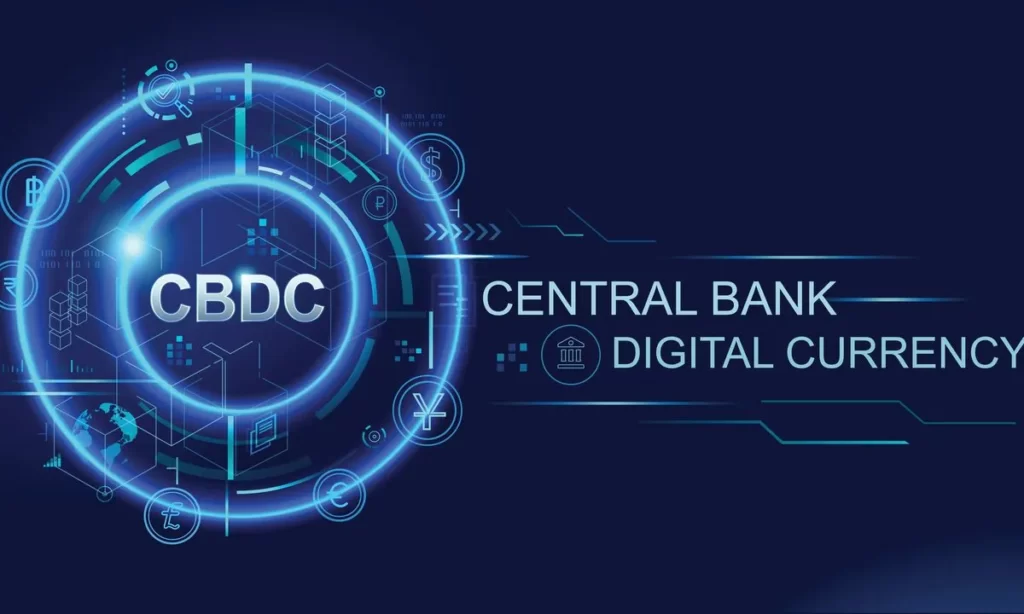A Beginner Guide to CBDC:
As cryptocurrencies and stablecoins have grown in popularity, central banks around the world have realized that they must provide an alternative to physical money or risk missing out on the future of money.

Central Bank Digital Currency (CBDC)
A Beginner Guide to CBDC: A central bank digital currency or CBDC is a virtual currency backed and issued by a central bank. Central Bank Digital Currency (CBDC) is a digital form of a country’s currency issued by the country’s central bank. Rather than printing money, the central bank issues government-backed and generally accessible digital coins or tokens that have the same value as the national currency.
CBDCs, also known as Central Bank Digital Currencies, are virtual tokens that are distributed by a central bank. They are linked to the value of the fiat currency used in their country. CBDCs are being developed by several countries, and some have already put them into practice. Understanding digital currencies and what they signify for society is crucial since so many nations are looking at how to make the shift, especially in this digital age.
Paper notes and coinage served as the conventional forms of fiat money, but technological advancements have made it possible for authorities and financial institutions to replace the physical form of fiat money with a credit-based system in which balances and financial transactions are tracked digitally.
The current trend of CBDCs became mainstream in 2020. However, the fundamental concept of establishing a digital currency has been in the works for several decades. Central authorities were the first to launch these currencies like e-gold in 1996. According to Wikipedia – e-gold was a digital gold currency operated by Gold & Silver Reserve Inc. (G&SR). G&SR allowed users to open an account on their website to send or receive gold and other precious metals to and from other e-gold accounts.

Unfortunately, their operations were suspended in 2009 due to legal troubles. But before then, the e-gold system had grown to five million accounts, and at its peak in 2006, it was processing over US$2 billion worth of transactions per year.
How do CBDCs work?
A Beginner Guide to CBDC: CBDCs are created and issued by central banks, which are responsible for the management and circulation of the currency. They are typically based on blockchain technology, which allows for secure and transparent transactions.
CBDCs can be divided into two main categories: account-based and token-based. Account-based CBDCs are similar to traditional bank accounts and are linked to the holder’s identity. Transactions are recorded on a centralized ledger and are visible to the central bank. Token-based CBDCs, on the other hand, are more similar to cryptocurrencies and are not linked to the holder’s identity. Transactions are recorded on a decentralized ledger and are not visible to the central bank.

Benefits of CBDCs
A Beginner Guide to CBDC: CBDCs offer a number of benefits over traditional fiat currencies and cryptocurrencies. These include:
Increased financial inclusion: CBDCs can provide access to banking services for those who are unbanked or underbanked.
Improved efficiency and speed: CBDCs can facilitate faster, and cheaper transactions compared to traditional fiat currencies.
Increased security: CBDCs can reduce the risk of fraud and money laundering, as transactions can be recorded on a blockchain.
Improved monetary policy: CBDCs can provide central banks with new tools for implementing monetary policy and managing inflation.
Risks of CBDCs
A Beginner Guide to CBDC: Despite the potential benefits, there are also risks associated with the introduction of CBDCs. These include:
CBDCs bring with them a number of potential risks, both from a technical and a societal perspective. One of the major concerns is the potential loss of privacy. With a CBDC, transactions can be tracked in real time by the central bank, which raises serious privacy concerns. This could potentially lead to a loss of financial privacy and autonomy for individuals.
Another risk associated with CBDCs is the potential for authoritarian or even dystopian government control. With a CBDC, governments would have unprecedented access to financial data, which could be used to track and control citizens. This could be particularly concerning in countries with a history of human rights abuses or political repression.
In addition, the use of CBDCs could lead to a rise in financial surveillance and tracking. This could be used to monitor and control financial activity, potentially leading to a reduction in personal freedom and autonomy.
Another risk is that CBDCs may be used to enforce more stringent regulations and taxes, which could lead to increased costs for businesses and individuals. This could have a negative impact on economic growth and financial stability.
Lastly, CBDCs could also be used to implement restrictive monetary policies or even negative interest rates, which could lead to a reduction in the purchasing power of citizens and increase the risk of deflation.
Overall, while CBDCs have the potential to bring about many benefits, it’s important to consider the potential risks and to ensure that proper safeguards are in place to mitigate them.

Different Types of CBDCs
CBDCs come in two varieties: retail and wholesale, as well as hybrids that blend features from both. Below are their differences and details on how they operate:
Retail CBDC
The general public is granted retail CBDCs. According to this paradigm, customers can store CBDCs in a wallet or account and utilize them to make purchases. Individuals can treat CBDC as a public digital banking alternative.
For customers who lack access to regular financial services, it could be extremely useful. Additionally, since the money is backed by the government, there is no chance of a banking collapse. The U.S. is one of several nations that have opted to adopt the retail CBDC model.
There are two types of retail CBDCs:
Token-based retail CBDCs – These digital currencies are accessible with public or private keys, which provide transaction anonymity.
Account-based retail CBDCs – These digital currencies require digital identification for users to open, access, and use an account.
Wholesale CBDC
The adoption of wholesale CBDCs is used by the banking sector. A central bank’s CBDC might be used by banks and other financial institutions to expedite money transfers and process transaction settlements. While this kind of CBDC boosts local payment efficiency, it is also highly beneficial for international payments.
Increased security is a further advantage of a wholesale CBDC. These currencies’ use of a digital ledger to execute and store transactions could make it easier to combat financial fraud. A few nations, like Singapore, Malaysia, and Saudi Arabia, are concentrating on a wholesale CBDC. However, the majority are working on either a retail or hybrid CBDC.

Advantages of CBDC
There are a few prominent disadvantages of CBDC, including:
Accessibility
In comparison to the present financial system, a CBDC distributed via blockchain technology is less expensive, quicker, and maybe more accessible. A CBDC may be used by anybody with a mobile device, and digital currencies are a means of bringing together businesses and local residents.
Security
A CBDC network is ideally created using impermeable blockchain technology. The network would operate as a reliable historical ledger of every transaction for the central bank. Such monitoring can help banks combat criminal behavior like financial fraud by allowing them to identify and investigate any questionable transactions.
Disintermediation
With the use of blockchain technology, both firms and individuals could transfer funds in any way they pleased. A CBDC limits the amount of money that may travel as well as where it can go by eliminating the need for banks or other comparable financial management organizations to authorize transactions.

Disadvantages of CBDC
There are a few prominent disadvantages of CBDC, including:
Control & Ownership
A CBDC would undoubtedly give the government greater control over citizens’ money because of the ability to fully monitor all transactions due to the CBDC’s digital nature. CBDC may be problematic for those who seek less government control over their financial life.
Lack of Banking Alternatives
Citizens who transfer their money to a central bank in order to benefit from the CBDC risk limiting their banking choices to just that one institution. Since a CBDC eliminates the need for neighborhood or regional banks, it gives a central bank complete authority. The transition may be difficult for citizens who prefer to utilize conventional banks over government banks.
Greater Risk
With the government controlling CBDC, the bank would be responsible for any threats to the system or errors. The reputation of the central bank would be permanently damaged if incorrect data has been entered or if there was a fault in the system. In a similar vein, the lending and debt services provided by conventional banks would need to be covered by central banks.

CBDC vs Cryptocurrency
A Beginner Guide to CBDC: Digital currencies issued by central banks are commonly mistaken for other types of cryptocurrencies. As stated previously, central bank digital currencies have central banks at the heart of every transaction. However, cryptocurrencies, such as Bitcoin, are digital tokens created using cryptographic methods by a distributed network or blockchain.
Cryptocurrencies employ permissionless (public) blockchains, whereas CBDCs use permissioned (private) blockchains. Anyone can join and participate in the blockchain network’s essential operations in a public blockchain. The ongoing operations on the public blockchain network can be read, written, and audited by anybody, which helps a public blockchain preserve its self-governed nature. A private blockchain, on the other hand, is a distributed ledger that functions as a closed, secure database based on cryptography concepts and is not decentralized.
The restrictions on CBDC networks are set by a central bank. The authority is assigned to the user base on crypto networks, which makes choices by achieving a consensus.
Therefore, while cryptocurrencies are decentralized, CBDCs are centralized. Moreover, cryptocurrencies provide anonymity; CBDCs allow central banks to see who owns what. CBDCs are more likely to run on distinct technological platforms than cryptocurrencies, which are often established utilizing blockchain.
Although a CBDC is a digital currency that can run on a blockchain, it is not a cryptocurrency. Four key differences exist between both assets:

Cryptocurrencies are primarily decentralized, while CBDCs are centralized.
Cryptocurrencies offer anonymity for financial transactions, while the central bank fully knows CBDC transaction details.
Cryptocurrencies are generally not backed by the government, while CBDCs would have full government support.
Cryptocurrencies (except stablecoins) are volatile, while CBDs are stable because they are digital versions of a country’s currency.
CBDCs vs Bitcoin
Bitcoin may have been the first crypto to gain widespread acceptance, and it certainly dominates blockchain and crypto discussions, but it is just one of the thousands of crypto assets available.
The attraction, utility, and principles of Bitcoin have not been weakened or lessened by the advent of different crypto variants. Instead, the growth of stablecoins, CBDCs, and other blockchain and crypto-related applications has improved the ecosystem’s overall health.
The Bitcoin ecosystem offers a glimpse of an alternative financial system in which transaction terms are not dictated by onerous regulation. Bitcoin, which was founded in 2009, is one of the world’s most popular cryptocurrencies. Bitcoin doesn’t represent tangible coins that change hands. Transactions are instead traded and recorded in a public, encrypted ledger that anyone can access. All transactions can be validated via the mining process. Banks or governments do not back Bitcoin.
CBDCs are supposed to be used as a substitute for fiat currencies. The idea is to provide consumers with the ease and security of digital as well as the traditional banking system’s regulated, reserve-backed circulation. They’re made to serve as a store of value, a unit of account and a medium of exchange in everyday transactions.

Pros and cons of central bank digital currencies
Pros of CBDCs
There are several benefits of central bank digital currencies, including:
Faster and Cheaper Transactions: CBDCs typically run on blockchain technology. Blockchain has a quicker processing time and lower processing fees than the current banking system. Users could send and receive their digital currencies within and outside the country faster and cheaper.
Banking the Unbanked: Many countries have a large number of people who don’t own bank accounts. They’re known as the unbanked. With a CBDC, anyone with an internet-enabled phone can sign up for an account or wallet to send and receive funds. There would be little to no need to visit a physical banking institution to fill out multiple account opening forms.
Enhanced Fraud Detection: All CBDC transactions are recorded and stored on a digital ledger. This will help authorities easily identify fraudulent transactions and other illicit operations.
See also” Quick guide on cryptocurrency.”
Cons of CBDCs
There are some drawbacks of central bank digital currencies, including:
Privacy Concerns: The central bank will completely control its central currency’s entire user data. An organization holding such amounts of sensitive information is a potential privacy disaster. Furthermore, the central bank can block certain transactions and prevent users from accessing their funds for arbitrary reasons.
Accessibility Barriers: Some people may not have the means required to use a CBDC, like a smartphone or internet access. Others may not trust the new currency and would instead stick to the type of money they’re familiar with.
Frequently Asked Questions (FAQs)
What are the requirements of CBDC?
the common principles require a CBDC and its underlying system to incorporate core features. These include ease of use, low cost, convertibility, instant settlement, continuous availability, and a high degree of security, resilience, flexibility, and safety.
What are the challenges of CBDC?
The legal and regulatory aspects are one of the key potential challenges associated with CBDC issuance. Current legislation in some jurisdictions may prevent or restrict the issuance of CBDCs.
What technology will CBDC use?
Blockchain is the key and fundamental technology of current digital cryptocurrencies. Central banks around the world are actively researching and exploring potential applications of blockchain in CBDC.
Can CBDC replace cash?
The CBDC obviates these problems. Plus, a digital wallet can hold any amount of cash, unlike a physical wallet, and seamlessly transfer money. Note, however, that money cannot be transferred to another person’s bank account. CBDC transfers are only to other digital wallets.





